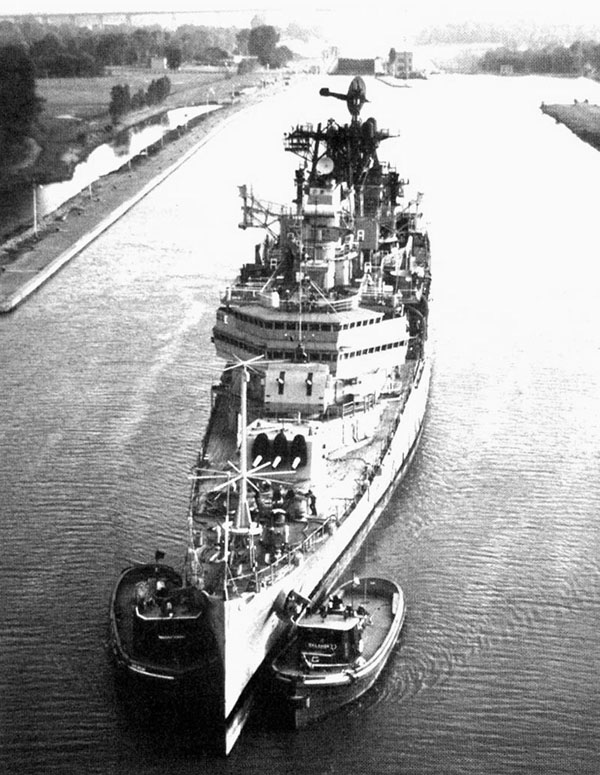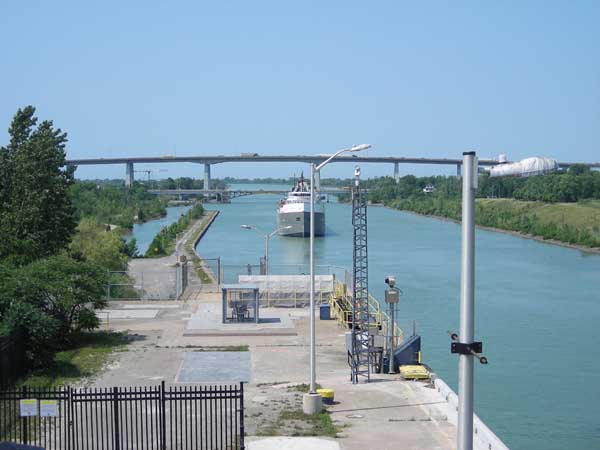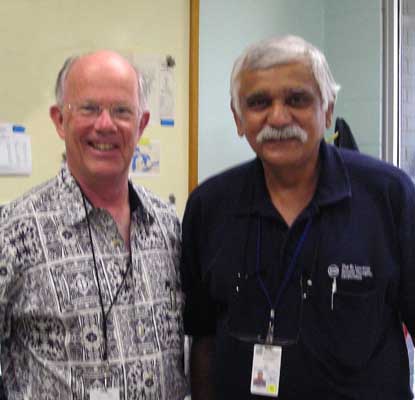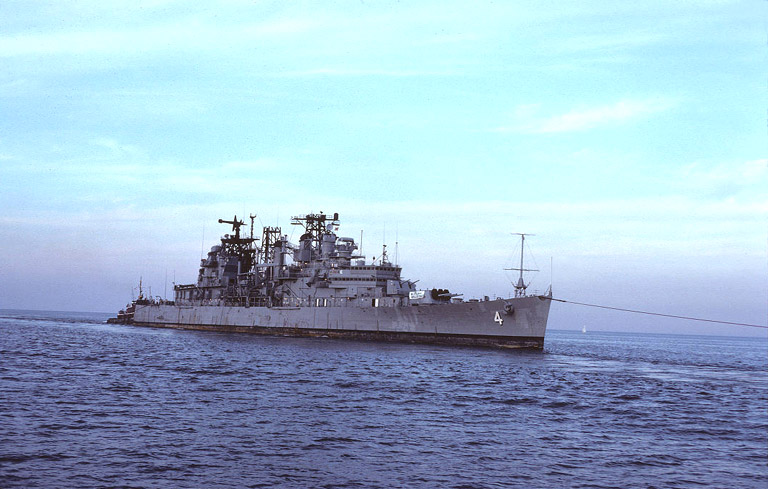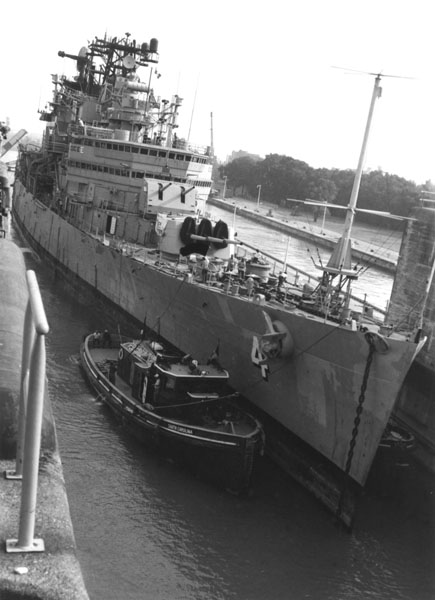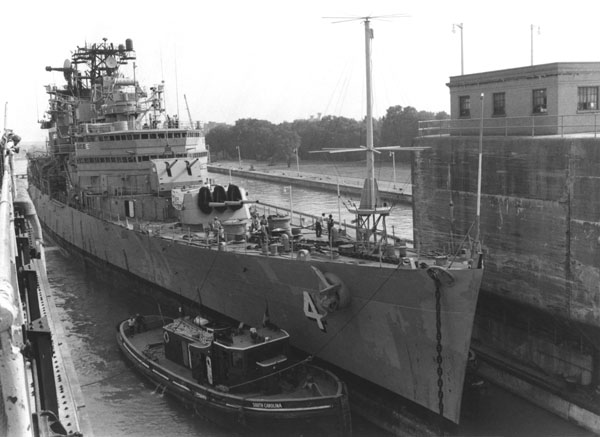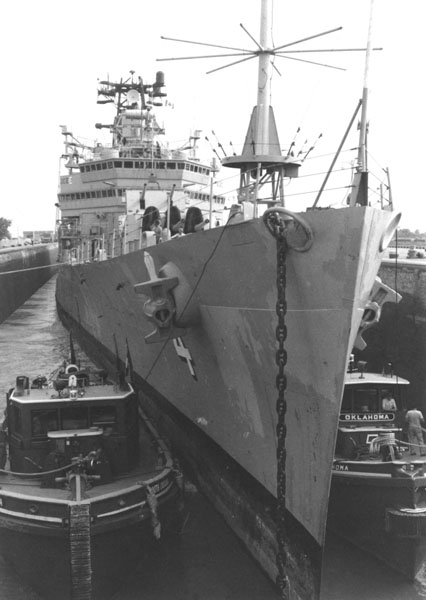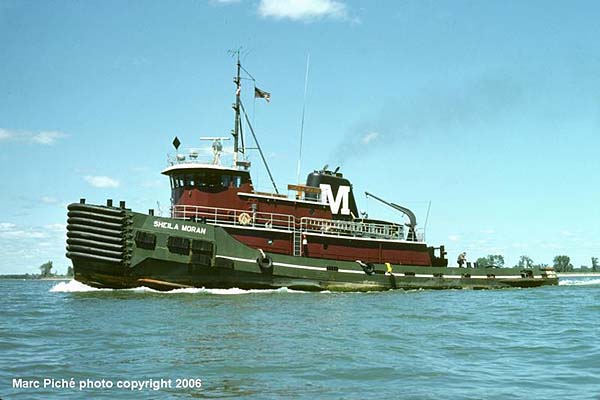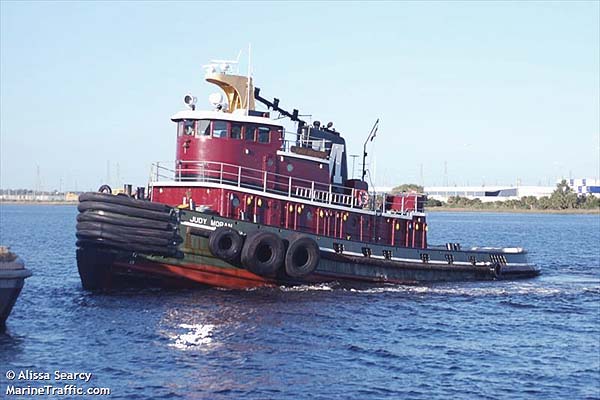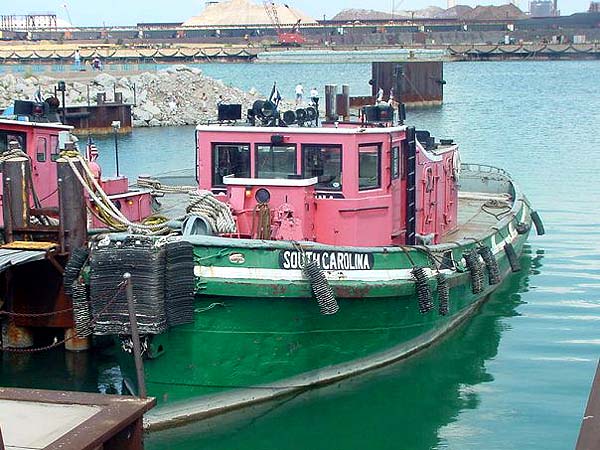How did the U.S.S. Little Rock
come to be at the
Buffalo and Erie County Naval & Military Park?
Page last updated: 22 July, 2017
A
Brief Introduction....
U. S. Navy ships don't just "happen" to become displays in naval parks. The process of finding, procuring and placing a ship into a park is both long and somewhat complicated. The information below will provide some of the facts, figures and photos of the events that brought the USS Little Rock to Buffalo. Enjoy the reading! |
How the U.S.S. Little Rock came to be at the Buffalo and Erie County Naval & Military Park By CDR John E. Conjura, USN-Retired On 24 December 1975, the City of Buffalo announced plans to establish a naval and servicemen's park and museum on a six-acre waterfront site on the Buffalo River at its juncture with Lake Erie. The project envisioned the acquisition of several decommissioned Navy surface ships, a submarine, PT boat, fighter aircraft and other memorabilia to be featured as a permanent memorial to honor the men and women who served in the Armed Forces during World War II and the post WW II period of the Cold War. The project was lead by Buffalo City Court Judge Anthony P. LoRusso, a Navy League member and chairman of the advisory committee for the Buffalo Naval and Servicemen's Park and Museum. Other key committee members were Louis J. Clabeaux, Jr., Buffalo Urban Renewal Agency and Project Officer for Ship Transfers, Charles L. Yeager, President of the Buffalo Council of the Navy League, and Thomas J. Reardon, Port of Buffalo Harbormaster and Supervisor for the Transfer of Ships from Philadelphia Naval Shipyard to Buffalo. Funding for the park and museum project was provided principally from the U.S. Economic Development Administration as part of federal urban renewal development projects in the Buffalo area. The Chief of Naval Operations (CNO) announced on 18 August 1976 that USS Little Rock CG 4 was to be decommissioned later that Fall. The 31 year old Little Rock had grown too old to operate effectively, and too tired to be overhauled economically. It was the end of the line for one of the best and most highly regarded "high-profile ships" in the US Navy. At the time of the CNO decommissioning announcement, Little Rock was serving as Flagship of the Sixth Fleet and was homeported in Gaeta, Italy. She had been serving as COMSIXTHFLT flagship in the Mediterranean since August 1973. In late summer 1976, Little Rock returned to the Philadelphia Naval Shipyard for inactivation, lay-up and ultimate disposition. The CNO announced on 18 August 1976 that USS Little Rock CG 4 would be decommissioned and stricken from the Naval vessel register on 22 November 1976. During the early months of 1976, the Servicemen's Park Committee presented their plan to the Buffalo Urban Renewal Agency (BURA). Through lengthy and tedious coordination, and meanwhile searching for support from other interested groups and individuals, the plan was formalized and presented to the Department of Navy. The Navy formally agreed to donate two decommissioned ships to Buffalo for display in a naval park. A team from Buffalo, headed by Louis J. Clabeaux of BURA, proceeded to Philadelphia to make the necessary ship transfer arrangements. BURA 's Clabeaux discovered that the WW II destroyer USS The Sullivans (DD-537) was available for donation from the Navy. The Sullivans was named after the five Sullivan brothers who died during WW II when their ship, the cruiser USS Juneau, was sunk on 14 November 1942 during the battle for Guadalcanal. But Buffalo's luck didn't end there with the green shamrock on The Sullivans stack. While Clabeaux was in Philadelphia at the Naval Shipyard to inspect the destroyer, the guided missile cruiser Little Rock, fresh from duties in the Mediterranean, was steaming into port for decommissioning. As Little Rock made her approach for mooring, the shipyard official turned to Clabeaux and asked, "How would you like her for your naval park?" The offer was not given or taken lightly. The Little Rock was destined to be decommissioned and stricken from the naval vessel register as The Sullivans already had been. That made her eligible for donation. On 3 February 1977, John J. Bennett, Assistant Secretary of the Navy, wrote Vice President Walter Mondale informing him the Navy had no further use for The Sullivans and Little Rock and agreed to give them to Buffalo. Vice President Mondale, as President of the Senate, notified the House and Senate Armed Services committees of the Navy's plans. The two congressional committees posed no objections to the ship's transfer to Buffalo. Judge LoRusso said he was especially pleased with the Little Rock, which he said, "is in great shape because it just came out of service." According to the Navy, it was the first time two ships had ever been donated to the same recipient at the same time. The actual ship transfer to Buffalo was arranged under a $250,000 state grant by Buffalo's Urban Renewal Agency, coordinated by BURA Director Louis J. Clabeaux. On 29 June 1977, two sea-going tugs and 15 volunteer crewmen began their journey of 2,180 nautical miles, towing the 376 foot, 2,050 ton The Sullivans and the 610 foot, 10,700 ton Little Rock from Philadelphia Naval Shipyard, up the Atlantic coast, through the St. Lawrence Seaway and the Welland Canal to Buffalo. To permit transit under hanging power lines straddling the Welland locks, about 95 feet of the Little Rock's masts and radar antennas were cut down by her volunteer crewmen in Philadelphia and secured on the after-missile deck for the voyage. On the night of 1 July, Little Rock almost collided with another ship in heavy fog. The two tugs, invisible in the fog, radioed that Little Rock was on a collision course with another vessel. Then radio communications ceased. The onboard emergency flares failed to ignite. The entire crew then directed flashlight beams toward the other ship and sounded fog horns. Finally, the other ship sighted Little Rock and maneuvered away. The eight crewmen who manned Little Rock in a "Cold Iron" condition endured significant hardships during the 17-day voyage. Except for the night before departure, when a bilge pump was hooked to a fire hose, there was no fresh water. Dishes were wiped, not washed. The crew sometimes slept only four hours during the voyage. After a long and tedious tow, Little Rock entered the Buffalo harbor channel at 9:25 p.m. and by 11:00 p.m., Friday 15 July 1977, was moored stern-to-stern with The Sullivans, which had arrived earlier on 04 July. As two retired Navy warships towered in the background, Buffalo's civic leaders, along with Navy officials, and a crowd of 3,000 gathered near the foot of Main St. at 2:00 p.m. on Sunday, 17 July 1977, to dedicate the city's new Naval and Servicemen 's Park. Congressman Henry J. Nowak, 37th Congressional District, announced that $1.4 million in federal funds had been approved by the U.S. Economic Development Administration for developing the Park. The principal Navy speaker was Rear Admiral Gordon R. Nagler, USN, Deputy Director, Command and Control and Communications (C3) Programs, Office of the Chief of Naval Operations (OP-094B) and former Little Rock Commanding Officer 1971-1972. Also speaking for the Navy was Mr. Stephen C. Yednock, Naval Sea Systems Command, Washington, whose office receives, negotiates, and finally issues the contracts for ship transfers approved by the Secretary of the Navy. Among the assembled welcoming crowd were two former Little Rock crew members, Burdett Rust and Brian Nicholas. They had last seen the ship when they completed their tours in Gaeta, Italy in 1974. "If someone told me then that the next time I'd see the Little Rock, she would be moored off Main St., I would have told him he was nuts," Rust said. Also in the crowd was former Chief Warrant Boatswain, (CWO-4, USN Retired) Marvin Curry of Lawtons, NY. CHBOSN Curry had served as Little Rock's "Ships Bosn" from 1966 to 1970. Before leaving the ceremony, CHBOSN Curry was introduced to city officials as the most highly qualified person in the world to care for Little Rock in her new role as the center- piece for the Buffalo Naval and Servicemen' s Park. Shortly thereafter, CHBOSN Curry signed a contract with the City of Buffalo, and with a crew of 15, maintained her and the other ships for 20 years until his retirement from the Park in 1998. (Submitted by CDR John E. Conjura, USN-Ret, Little Rock Communications Officer 1969-1972) Republished from LitComs Spring 2001 Issue |
The Transfer of U.S.S. Little Rock
from the U.S. Navy to Buffalo Naval Park Mr. Louis J. Clabeaux, Jr. of the Buffalo, New York Urban Renewal Agency and Navy Commander R.L. Clark, Officer-In-Charge of the Philadelphia Inactive Ship Maintenance Detachment, sign documents transferring the ex- U.S. destroyer The Sullivans and the ex- U.S. light guided missile cruiser Little Rock to the City of Buffalo on June 22, 1977. Looking on is Captain R.R. Allman, Chief of Staff for the Third Naval District. |
The Long Journey Getting a ship like the Little Rock to Buffalo, NY from Philadelphia, PA is not an easy feat. The voyage, by water is over 2100 miles long, and passes through some of the busiest sea lanes in the world. To allow the ship to pass under hanging power lines and under bridges along the way, about 95 feet of the Little Rock's masts and radar antennas were cut down in Philadelphia and secured on the 02 Level above the Missile House for the voyage. Because Little Rock was in "cold iron", that is, not under her own power, it was necessary to utilize tugboats to pull (and push) the ship the entire way from the shipyard in Philadelphia, down the Delaware River to the Atlantic Ocean, up the East Coast to the St. Lawrence Seaway, down the Seaway through seven locks (the St. Lambert lock - 18 ft, the Cote Ste. Catherine lock - 30 ft, the Lower and Upper Beauharnois locks - 82 ft total, the Bertrand H. Snell lock - 45 ft, the Dwight D. Eisenhower lock - 38 ft, and the Iroquois Guard lock - 3 ft), then west across Lake Ontario to Port Weller, Ontario, then "up" the Welland Canal (eight MORE locks - 326 ft! ) to Port Colborne, Ontario on Lake Erie, and then east about 20 miles to Buffalo, New York. In spite of the length of the journey and the attendant obstacles, it was on Wednesday, 29 June 1977 that Little Rock departed Philadelphia for Buffalo. Even after several harrowing incidents including a near collision with another ship in heavy fog, Little Rock entered the Buffalo harbor channel at 9:25 p.m. Friday 15 July 1977 and by 11:00 p.m. was moored stern-to-stern with USS The Sullivans, which had arrived on 04 July. LITTLE
ROCK on the St. Lawrence River
(Quebec) - July 10, 1977 USS Little Rock under tow on the St. Lawrence River on July 10, 1977 while bound for Buffalo, NY from Philadelphia, PA. Original photo was taken by Rene Beauchamp and found by the webmaster on ShipSpotting.Com. Photo is used by permission of Mr. Beauchamp. A comment was posted on the original website by Marc Piche (to Mr. Beauchamp): "We were together for this one. Taken off Sorel (Quebec) from a boat whose owner we had asked to take us to the ship. She was being towed by 2 big Moran tugs one being SHEILA MORAN if I remember well. The destroyer THE SULLIVANS had been towed up the Seaway a week before to Buffalo as well." Comment by Marc Piche on Apr 13, 2013: "Notice that her foremast and main mast were cut down due to air draft restrictions while passing under the St. Lawrence River and Seaway bridges. The mast tops were stowed vertically on the top deck aft of the mainmast with the large bedspring radar was stowed on the port side of the main deck abreast the main mast. All of these components were reassembled at Buffalo as the ship was being refitted as a floating museum. She was the second largest warship ever to transit the Seaway even if she was decommissioned. The US Navy Baltimore-class heavy cruiser USS MACON CA-132 was the largest ever (to have) transited the system in June 1959 to take part in Operation Inland Seas. She also had her top masts cut down prior to this cruise." |
|
A "modern engineering marvel", the 26 mile-long Welland Canal connects Lake Ontario and Lake Erie through a series of eight locks. The canal extends southward across Ontario, Canada from Port Weller, Ontario (on Lake Ontario) to Port Colborne, Ontario (on Lake Erie). The southern terminus of the canal at Port Colborne, is 326.5 feet higher than the northern terminus at Port Weller. As part of the St. Lawrence Seaway the canal allows ships to ascend and descend the "Niagara Escarpment" and to bypass Niagara Falls. About 3,000 vessels use the canal annually. Ships passing through the canal navigate eight ship locks, each of which is 80 feet wide by 766 feet long. The maximum length of a ship transiting the canal is 740 feet. The Garden City Skyway at St. Catharines which passes over the canal restricts the height of ships' masts to 116.5 feet (above the water). The Welland Canal (see map below) connects Lake Ontario and Lake Erie. The canal is oriented in a north-south direction, with the lower end being at Port Weller. Ship traffic moving from Lake Ontario to Lake Erie is considered to be moving "up" the canal in that the ship is lifted through the locks as it makes its way to Lake Erie. Conversely, ships heading from Lake Erie to Lake Ontario move "down" the locks. The photos below show LITTLE ROCK in the Welland Canal just after Little Rock had passed through Lock #3 on the canal. The photos were taken from atop the Glendale Avenue Bridge, also referred to as ("Bridge 5"), which is just up the canal from Lock #3. The empty Lock #3 is visible just above the ship's radar. In the far distance the Queen Elizabeth Way / Garden City Skyway bridge is faintly visible.
|
||||||
The Long Journey Getting a ship in "Cold Iron" from Port Weller, Ontario (at the western end of Lake Ontario) to Port Colborne, Ontario (at the eastern end of Lake Erie) requires "lifting" the vessel over 326 feet and pushing and pulling with several tugs the 26 mile length of the canal. After seeing the picture from the Buffalo News of the Little Rock in the Welland Canal (see above photo), the Little Rock Association's web-guy decided to find out more about this part of the Little Rock's 2,180 nautical mile journey. In July 2012, on a trip home from Wisconsin, Art and his wife Jane decided to take a "short-cut" through Ontario, Canada, hoping to verify that the above Buffalo News photo had in fact been taken in the vicinity of Welland Canal Lock 3. We knew there was a museum in the immediate vicinity of Lock 3 and figured that they would be able verify the location from which the photo had been taken. Indeed "Rose" at the museum seemed pretty sure that the photo had in fact been taken from the Glendale Avenue bridge just a short distance up the canal. As far as the exact date and time of the transit, Rose suggested we check with the St. Lawrence Seaway Management Corporation folks whose office was just a short distance from the museum. The St. Lawrence Seaway Management Corporation (Niagara Region) facility houses the staff and equipment necessary to orchestrate and insure safe transit of vessels through the western part of Lake Ontario, the Welland Canal, and the eastern part of Lake Erie. It turned out that the entire building is "secure" and an escort was required just to enter beyond the lobby. After inquiring of the Corporation's receptionist as to if and where records of ship transits might be kept, she told us she was pretty sure that the records of the Little Rock's transit would be stored at this facility. However, she felt sure they were not available for public viewing. She did however think that one of the "Captains" might be able to help us. And after a short phone conversation she informed us that "Captain Soni" would be coming out to talk with us. In very short order a distinguished gentleman came into the lobby and introduced himself as "Captain Anil Soni". After introductions all around I explained to Captain Soni that I was looking for any records that might detail the date and time of a 1977 ship transit through the Welland. (Up until that time I had not mentioned to the receptionist or Captain Soni the name of the vessel I was interested in.) I opened my binder and showed him a copy of the Buffalo News article photo. He glanced briefly at the picture and said "Oh, the Little Rock". (!) Shocked that Captain Soni knew of the Little Rock, I asked if he had perhaps visited her in Buffalo. He told me no, but that he had inspected her prior to her 1977 transit through the canal, and had supervised her passage. He then graciously invited Jane and me into his office to see what information he might have regarding the transit. As it turns out, Captain Soni had detailed records of meetings prior to the transit, the inspection, as well as several excellent 5" x 7" photographs of LITTLE ROCK with the tugboats, making the trip through the Welland Canal. On his insistence I accepted his kind offer of copies of the reports as well as of the photographs. What follows below are some of the details, as well as the photos that were so generously offered.
|
||||||||||||||||||||||||||||||||



